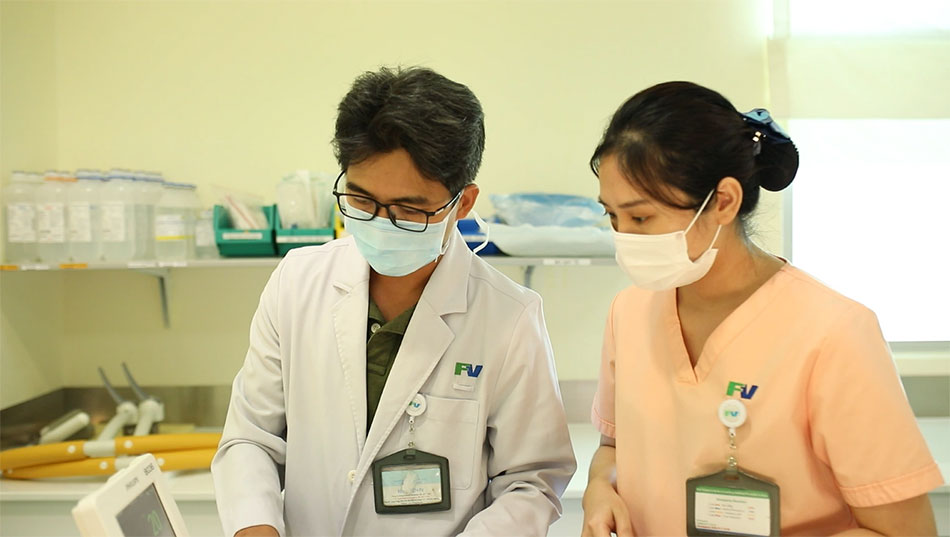Dr Vo Trieu Dat, Deputy Head of Obstetrics and Gynaecology, FV Hospital, says that recognising the risk factors for postpartum haemorrhage during pregnancy and preventing it from occurring during delivery is essential to ensure that babies arrive safely and that the mother remains in good health.
Postpartum haemorrhage is a common obstetric complication that can be life-threatening.
Continuously striving to prevent women from suffering a postpartum haemorrhage.
Patient Q. (36 years old, HCMC) was pregnant for the third time, showing signs of being in labour, and was taken to FV Hospital by her family. Through examination, the doctor found that the Ms Q. had signs of abnormally strong uterine contractions and foetal distress, so the doctor decided to appoint a caesarean section.
Dr Vo Trieu Dat, Deputy Head of Obstetrics and Gynaecology, FV Hospital, said that the caesarean section went smoothly, the baby girl was born healthy, crying loudly, and mother and baby’s vital signs were stable. However, immediately after the placenta detached from the womb, the mother began to bleed uncontrollably, her heart rate increased and blood pressure dropped, and the uterus did not contract.
Dr Dat said: “With our experience, we immediately think of uterine atony, an extremely dangerous obstetric complication. This is a phenomenon in which the uterus becomes flaccid, loses its tone and cannot contract tightly, and causes the blood vessels in the placental area that were attached to the uterus to not tighten after placental abruption. This causes free bleeding that leads to a lot of blood loss, also known as haemorrhage. If we don’t intervene in time, the mother can die from haemorrhagic shock.”

A successful caesarean section is performed by Dr Vo Trieu Dat in the operating room of FV Hospital
At this time, the entire team races against time to stop the bleeding and conduct surgery to suture the uterine artery and uterus and insert the uterine balloon. At the same time, the operating room medical staff, anaesthesiologist and laboratory team are told to prepare for a blood transfusion procedure for the new mother. All emergency work takes place promptly and appropriately.
Dr Dat shared that: “In most cases, if uterine artery ligation and B-Lynch stitches still do not stop the bleeding, the last solution is usually hysterectomy. While this is not life-threatening, it can affect mental health and physiology of a young female patient.”
Luckily, FV’s team of doctors was able to stop the bleeding and conserve the uterus. Ms Q. received eight units of blood and plasma, her vitals returned to normal and she was discharged after seven days.
Postpartum haemorrhage: a dangerous obstetric complication
According to the World Health Organisation (WHO), tens of millions of women worldwide experience postpartum haemorrhage every year. This is the most common of five obstetric complications, along with pre-eclampsia, postpartum infection, amniotic fluid embolism and uterine rupture. Postpartum haemorrhage is a condition of heavy bleeding defined as abnormal blood loss of more than 1,000ml of postpartum blood within or longer than 24 hours.

Dr Vo Trieu Dat examines a patient to monitor their pregnancy at FV Hospital
Women most at risk of postpartum haemorrhage are those that deliver, pre-term; enter the second stage of labour but don’t progress further; have not maintained good maternal nutrition; are aged under 20 or over 35 years old; develop eclampsia and related disorders; have a prolonged labour; and retain the placenta.
According to Dr Vo Trieu Dat, there are many causes of postpartum haemorrhage, of which the main cause is uterine atony (womb does not contract) as in Ms Q.’s case and accounting for 70 to 80 per cent of all cases. The cause of uterine atony may be due to the prolonged delivery process, which causes the uterus to contract many times until it is in an extremely weakened state. When the mother begins to deliver, it is no longer able to contract. In the case of twins or triplets, the uterus also contracts more than delivering a single child and the muscle is more likely to become exhausted. If the patient has a caesarean section, the anaesthetic may cause the uterus to become numb and unable to contract. Damage to the genital tract, such as a vaginal tear, can also lead to atony, as can blood clotting disorders, retained placenta, uterine infection and endometriosis.
How can the risk of postpartum haemorrhage be reduced?
All births have potential risks, and doctors must carefully pay attention to each unique patient case, even normal, low-risk cases, as postpartum haemorrhage is a complication that can happen unexpectedly at any time. Dr Dat said: “In just one minute, a mother can lose 500 to 600 millilitres of blood. If we don’t address the situation in time, it can be very dangerous for the patient.”
Dr Dat explains that preventing postpartum haemorrhage is one of the most important ways doctors can protect the health of a pregnant patient. Measures include consistent monitoring of the pregnancy, detection of high-risk pregnancies, support regarding delivery technique, limiting the duration of labour and careful postpartum monitoring during six hours of delivery, particularly within the first two hours. Pregnant women need to choose a reputable hospital with modern equipment, a strong obstetrician and resuscitation department, and an onsite blood bank to ensure safety during pregnancy and childbirth.

The Department of Obstetrics and Gynaecology, FV Hospital, always prepares carefully in case of postpartum haemorrhage
FV Hospital is a multidisciplinary hospital where all departments support each other and are staffed by a team of highly skilled, experienced professionals who are always ready to collaboratively handle complications. FV’s onsite pharmacy is stocked with international-standard drugs to help control blood and uterine contractions. In cases of postpartum haemorrhage, the possibility of saving the mother is very high.
FV Hospital is always ready to take prevent action, variously using medical drugs, surgical intervention, uterine compression, artery ligation, and procedures such as balloon insertion. FV’s laboratory is always ready for active blood transfusion, sourcing from all available blood banks. Pregnant patients who choose to give birth at FV Hospital can rest assured that they will receive world-class multispecialty support in the event of any obstetric complication. Expecting mothers are also carefully consulted by highly specialised doctors during pre- and postnatal monitoring to minimise any potential for postpartum haemorrhage.
To book an appointment at the Obstetrics & Gynaecology Department-Breast Care Clinic, FV Hospital, please contact (028) 54 11 33 33, ext. 6000.



